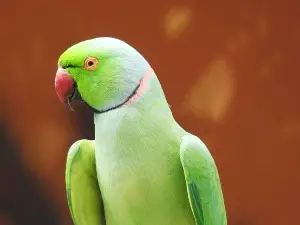
While birds look quite sturdy and seem as though nothing can phase them these animals can develop a number of conditions and illnesses, illnesses that cause issues with the bird’s beak.
This article is a look at the common issues that can affect your indian ringneck’s beak.
Table of Contents
Indian ringneck beak problems:
Knowing which ailments are common in your type of bird will help you spot issues in your bird quickly and will help you treat and resolve the bird’s condition quickly as well.
Here are a few things that you should look out for if you’re raising an Indian ringneck:
Change in beak color:
This isn’t necessarily an issue but it is something that you should know happens. Your Indian ringneck’s beak will change color as the bird ages, this is normal and is not something to worry about.
The bird will start off with a beak that is one color and then the beak will change color to another shade with age. The color change can also be caused by the bird’s diet, an injury, bruising, fungus, or malnutrition.
Your Indian ringnecks beak will turn a red-purple color as the bird ages.
What to do:
You don’t have to do anything in this case, a change in your bird’s beak does not signal that something is wrong, it simply signals that the bird is aging.
Pale-looking beak:
While a change in your bird’s beak color is caused by age, a lack of appropriate food and then malnutrition will cause the bird’s beak to start to look quite pale.
Ringnecks need a diet that is rich in the foods that they usually eat in the wild as well as specialized food developed for the birds. Foods that are helpful in maintaining the beak’s natural coloring include nuts, fruits, veggies, seeds, and pellets.
If there is a lack of variety in the bird’s diet then the bird’s beak can become pale. Also, if the bird’s diet is composed of only seeds then the bird’s beak can turn black
What to do:
Take a closer look at your bird’s diet to see if the bird is actually eating the appropriate foods and that the bird is eating a variety of foods. Also, make sure that the bird is actually eating the food and not leaving it out because it doesn’t like it.
If the bird isn’t eating food that it doesn’t like then you may have to substitute this food for something else to get the bird to eat.
Trauma to the beak:
This is something that can happen to and damage your bird’s beak, if it is injured the beak can grow back but this isn’t always the case.
Pet ringnecks can injure their beaks in a number of ways including fighting with other birds, flying into windows, chewing on electric cords, falling onto their beaks, or getting their beak trapped somewhere
What to do:
As long as the injury to the bird’s beak is minor, like if there is a small chip on the bird’s beak, then you don’t have to worry about the bird’s beak, the bird will continue to eat and act normally in this case and the keratin on the beak will grow back.
If there is a serious injury to the bird’s beak then you’d need to get the bird to the vet for treatment quickly. If the bird’s injury is painful and interferes with the bird’s ability to eat then the injury is likely quite serious.
Abnormal growth:
Abnormal growths usually develop in younger birds but they can develop in older ringnecks as well. Abnormal beaks are generally a misalignment of the bird’s beak, which causes the bird’s beak to not close properly.
A scissor beak is an example of an abnormal beak, this is where the upper and lower parts of the bird’s beak face different directions causing the bird’s beak to look like unclosed scissors. A beak that grows too long is also an example of abnormal beak growth.
What to do:
Addressing the bird’s beak involves taking the bird to the vet and having them fix the bird’s beak using dental appliances. These are a bird’s equivalent to braces and will realign the bird’s beak over time.
Getting treatment for the bird is important as without it the bird can develop issues with closing their mouth which can negatively affect the bird’s ability to eat, these conditions can also be very painful for the bird.
If you enjoyed this article then you may also be interested in other bird related articles. Here are some articles that you may be interested in: Budgie Squeaking When Flying, Budgie Flapping Wings On Perch, Why Is My Bird Flapping Its Wings At Me, Budgie Talking Silently, Bird Nail Ripped Off, Budgie Opens Beak When I Talk To Him, Bird Tilting Head Sideways, Budgie Hissing Sound, Budgie Cooing

